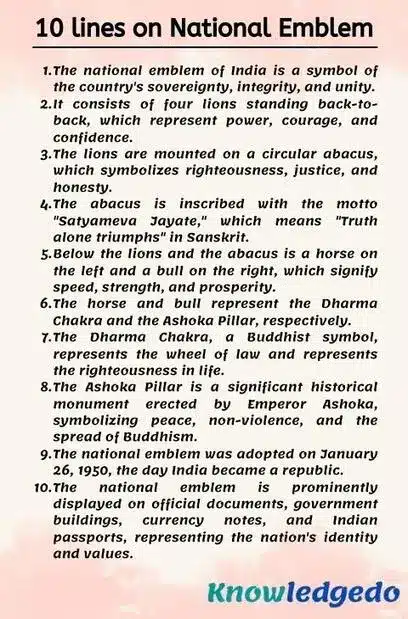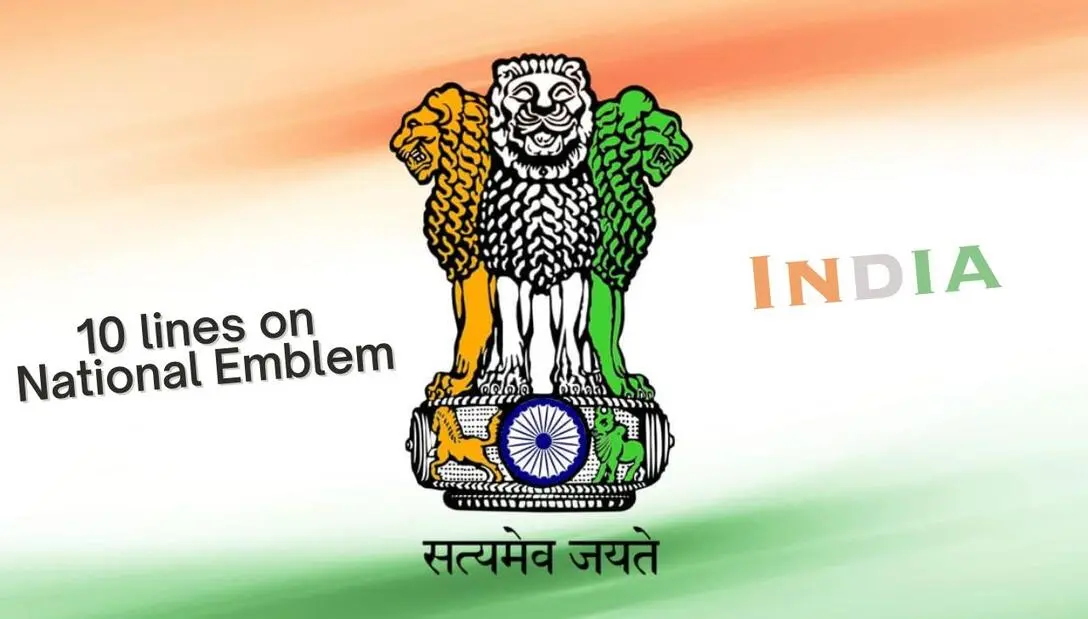Today, we are sharing 10 lines on National Emblem in English. This article can help students who are looking for information about 10 lines on National Emblem. This Lines is very simple and easy to remember. The level of these Lines is moderate so any student can write on this topic.
This article is generally useful for class 1,class 2,class 3,class 4,class 5,class 6,class 7,class 8,class 9,class 10,class 11,class 12
10 lines on National Emblem
1) The national emblem of India is a symbol of the country’s sovereignty, integrity, and unity.
2) It consists of four lions standing back-to-back, which represent power, courage, and confidence.
3) The lions are mounted on a circular abacus, which symbolizes righteousness, justice, and honesty.
4) The abacus is inscribed with the motto “Satyameva Jayate,” which means “Truth alone triumphs” in Sanskrit.
5) Below the lions and the abacus is a horse on the left and a bull on the right, which signify speed, strength, and prosperity.
6) The horse and bull represent the Dharma Chakra and the Ashoka Pillar, respectively.
7) The Dharma Chakra, a Buddhist symbol, represents the wheel of law and represents righteousness in life.
8) The Ashoka Pillar is a significant historical monument erected by Emperor Ashoka, symbolizing peace, non-violence, and the spread of Buddhism.
9) The national emblem was adopted on January 26, 1950, the day India became a republic.
10) The national emblem is prominently displayed on official documents, government buildings, currency notes, and Indian passports, representing the nation’s identity and values.

5 lines on National Emblem
1) The national emblem is a symbol of pride and identity for a nation.
2) It encapsulates the core values, history, and aspirations of a country.
3) The design of a national emblem often incorporates significant cultural, historical, or mythological elements.
4) It serves as a visual representation of a nation’s sovereignty and unity.
5) The national emblem is often displayed on official documents, government buildings, currency, and national flags.
FAQ
Answer: The national emblem of India holds great significance as it represents the sovereignty, integrity, and unity of the country. It embodies the values of power, courage, righteousness, justice, and prosperity.
Answer: The design of the national emblem was adopted from the Lion Capital of Ashoka, which is a historical monument from the Mauryan period in India. It was chosen for its historical and cultural significance and its association with Emperor Ashoka, who embraced principles of peace and non-violence.
Answer: The motto “Satyameva Jayate,” which translates to “Truth alone triumphs,” is inscribed below the national emblem. It is derived from ancient Indian scriptures and conveys the importance of truth, righteousness, and the ultimate victory of truth over falsehood.
Answer: The national emblem can be seen in various places throughout India, including government buildings, official documents, Indian currency notes, and passports. It is also displayed prominently during national events, ceremonies, and on important national occasions.
Answer: Yes, the national emblem of India is unique to the country and is a symbol of its national identity. While some elements of the emblem have historical and cultural influences, the specific arrangement and combination of those elements make it distinct and representative of India.
